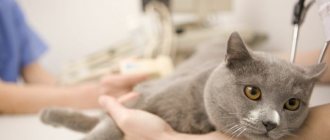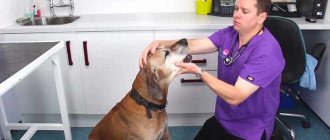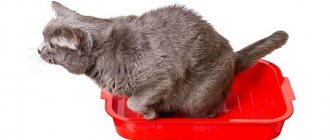July 17, 2020
Pyometra - purulent inflammation of the uterus - is one of the most common diseases of the reproductive system of cats, and also one of the most dangerous.
This disease is caused by a bacterial infection and occurs in acute or chronic form with the accumulation of purulent exudate in the uterine lumen and can have a variety of clinical manifestations.
With the progression of symptoms and the absence of timely treatment, pyometra leads to peritonitis, which occurs due to rupture of the uterine wall under the influence of a large amount of accumulated purulent exudate.
Who can get pyometra?
Cats are less likely to develop pyometra than dogs. This may be due to less progesterone being released. Unfortunately, due to the lower prevalence of the disease in cats, fewer factors are known to contribute to or prevent the development of pyometra in cats.
However, it is known that older animals are most susceptible to the disease; the risk of the disease increases significantly after 7 years, the average age of onset of pyometra is 5.6 years. Despite this, pyometra can also occur in very young animals - even a ten-month-old cat can get sick.
Only castration can completely prevent the development of purulent inflammation of the uterus. A cat’s history of childbirth, according to research, also does not in any way protect it from the disease.
It is also reliably known that previous hormonal therapy associated with the intake of progesterone contributes to the development of pyometra, therefore the use of drugs to suppress sexual estrus in animals is extremely undesirable.
Caring for an animal after surgery
Competent postoperative care for the animal is very important to prevent the development of complications and the speedy restoration of normal functioning. The pet owner must:
- for the first time after surgery, to prevent the animal from licking the stitches, dress it in a blanket;
- regularly inspect the stitches and if redness and inflammation appear, immediately visit a veterinarian;
- feed the cat liquid and semi-liquid foods, do not forget about a sufficient amount of water in the bowl.
If you suspect a deterioration in your pet's condition, you should not postpone a visit to the doctor.
Connection with hormones
The etiology of purulent inflammation of the uterus is associated with changes in the titer of sex hormones during the reproductive cycle. Pyometra is called a progesterone-dependent disease, it manifests itself in a phase of the cycle in which the concentration of progesterone is high and estradiol is low. This phase is diestrus - the end of estrus and the period immediately following it until the stage of ovarian rest.
Progesterone promotes the growth of the uterine glands, an increase in the amount of their secretion, the closure of the cervix, a decrease in the number and intensity of its contractions, which creates the ground for the subsequent proliferation of microflora and the development of the disease. Progesterone also mediates the pathological proliferation of endometrial glands and the formation of cysts, thus causing glandular cystic endometrial hyperplasia, a disease that often precedes and accompanies pyometra.
No less important is the second factor that causes purulent inflammation of the uterus - a bacterial infection. During estrus and shortly after its end, the internal environment of the cat's uterus is optimal for a possible pregnancy, but also for the growth of microorganisms due to the presence of a large amount of uterine gland secretion and suppression of the immune system. And when pathogenic or conditionally pathogenic microorganisms enter the uterus, inflammation begins.
Preventive actions
Prevention of pyometra in cats is as follows:
- carrying out sterilization before or after the first heat, if the animal does not participate in breeding;
- conducting a scheduled annual ultrasound examination of the animal’s reproductive system;
- monitoring the progress of labor, if it drags on too long, you should contact a veterinarian;
- Constantly monitoring the animal’s condition and if dangerous symptoms are detected or discharge appears, contact a veterinarian with the cat.
In addition, you should not give your pet contraceptives that eliminate estrus. Since if they are used frequently, the cat becomes susceptible not only to the development of pyometra, but also to cancer of the uterus or mammary glands.
Bacteria that causes pyometra
The most common bacteria that cause the development of pyometra are three genera:
- Escherichia (most often the bacterium Escherichia coli, also called “Escherichia coli”), is isolated from the affected uterus.
- Streptococcus (streptococci).
- Staphylococcus (staphylococcus).
Bacteria and their metabolic products, such as various toxic compounds, begin to circulate in the body, causing inflammation in various organs and systems, and can lead to fever, tachycardia, tachypnea (rapid breathing), shock and failure of internal organs.
Pyometra is characterized by an effect on the entire body of the animal; according to statistics, a septic process was detected in 86% of cats with pyometra.
Diagnostics in a veterinary clinic
The disease can only be diagnosed at a veterinary hospital. You should not do anything on your own, since there is a risk of harming the endometrial walls by palpating the swollen abdomen.
To confirm suspicions, you will have to carry out more than just palpation. The following procedures are also required:
- blood collection and analysis;
- scraping cytology;
- electrocardiogram;
- X-ray;
- ultrasound examination of the pelvis.
Thanks to the information obtained, it is possible not only to understand whether the disease is present, but also to determine the amount of pus. This data will help you choose a treatment method for your cat: with medications or surgery.
Medication method
In most cases, medication treatment is ineffective. Because of this, surgery is usually resorted to. The drug method can cure cats with a strong immune system and excellent health. Antibiotics and hormonal medications used can weaken the body and stimulate the uterus to shrink. This may result in the following consequences:
- miscarriages or sick kittens born;
- endometrial rupture;
- exacerbation of chronic diseases;
- infertility;
- repetition of the situation with pyometra.
It is better to resort to surgery, and you should agree immediately after the diagnosis is made.
Symptoms of pyometra in cats
Clinical symptoms of pyometra usually appear between 2 and 4 months after the end of estrus (but can appear at any other phase of the cycle) and can be varied.
Most often, mucous, purulent, and bloody discharge from the loop occurs, but they may not appear in closed type pyometra (in cats in 40% of cases). In this case, the cat will develop general symptoms indicating intoxication of the body and damage to various organs and systems.
The most classic symptoms are: exhaustion, depression, frequent urination, thirst, rapid heartbeat and rapid breathing, weak pulse, change in color of visible mucous membranes. Less common are fever, dehydration, abdominal tenderness, vomiting, diarrhea, and changes in the cat's gait.
Danger and complications
The main danger of the disease is death from acute peritonitis. It occurs when the endometrium ruptures, causing the entire abdominal cavity to fill with pus.
Another possible complication is falling into a coma due to dehydration. In this case, the body is severely depleted, so the likelihood of recovery is minimal. Most often, the animal dies without regaining consciousness.
How is the diagnosis made?
Making a diagnosis of “pyometra” is not difficult in classic cases based on history, examination, and physical examination, but there are also difficult cases with an atypical picture of the disease.
To make a diagnosis, the cat will need to be examined: blood tests, an ultrasound examination of the abdominal cavity, and an x-ray may be required.
A clinical blood test usually shows a high number of immune cells: leukocytes, monocytes, neutrophils and anemia; a biochemical blood test indicates kidney damage.
An X-ray examination can show the size of the cat's uterus, and an ultrasound can also help detect fluid in the organ cavity. If research data is available, the diagnosis will be final and reliable. Additional diagnostics are almost never required.
Treatment of pyometra
There are two main treatment strategies for pyometra: surgical and conservative.
Surgical treatment is the most common and safest method: it is guaranteed to stop the development of the disease and remove the source of infection from the cat’s body.
The operation to remove the ovaries and uterus (ovariohysterectomy), which is performed for purulent inflammation of the uterus, begins after stabilizing the patient with the help of an intravenous infusion, carried out to relieve intoxication and restore fluid balance in the body.
During surgery, monitoring is aimed at maintaining normal blood circulation, gastrointestinal function, maintaining breathing and the required depth of anesthesia. The removal of the uterus is carried out very carefully to prevent its contents from entering the abdominal cavity. The bladder can be emptied if necessary by puncturing its wall (cystocentesis).
Postoperative period
After surgery, the cat should be monitored for 1-2 days in a hospital or at home. Treatment is prescribed in the form of antimicrobial and supportive therapy. As a rule, the recovery period lasts 2 weeks, after which the consequences of the disease and surgery disappear.
In the postoperative period, it is important to strictly follow all doctor’s instructions. Your cat may be prescribed a variety of medications, including injections (shots) and infusions (droppers). Owners will need to monitor the condition of the cat, inspect the seam, ensure that it remains dry and clean, and treat it if necessary. After surgery, it is important to prevent the animal from hypothermia, not to expose it to stress, and to feed it regularly.
The prognosis for surgery is quite favorable and depends on the age of the cat, the presence of concomitant pathologies and, first of all, the severity of the disease. Mortality during surgical treatment of pyometra ranges from 3 to 20%. A cat with uterine rupture and subsequent peritonitis has a 57% chance of dying during and after surgery, so it is so important to pay attention to the first signs of illness in the animal.
When surgery cannot be avoided
If a cat is diagnosed with closed pyometra, then surgery is mandatory. Other indications for emergency surgery include neoplasms and uterine rupture.
The operation involves removing not only the uterus, but also both ovaries, which completely eliminates relapses. When performing it, the laparoscopic method is increasingly used, which does not require large incisions and is limited to the application of intradermal sutures.
Carrying out the intervention
The procedure for removing reproductive organs is similar to conventional castration, but carries much more risks. This is due to purulent exudate, complicating the surgeon’s work.
If there is too much of it, the endometrium may rupture during surgery. For this reason, the animal is prescribed hormonal drugs that reduce internal pressure due to the partial removal of pus.
Other complications include internal bleeding and negative reactions to surgical sutures. In the latter case, the operation must be repeated.
You should not be afraid of the listed risks, since the consequences of the pathology itself are much more serious.
The same applies to general anesthesia. The dosage is selected individually for each patient, excluding a negative reaction to the administered drugs.
Recovery period: care and nutrition
After the pyometra is removed, a special bandage is put on the cat to protect the sutures from damage. The recovery period takes about 10-20 days, but the first improvements are noticeable already on the 2nd day. Until this point you need to:
- Maintain a fasting diet for 24 hours so as not to provoke vomiting.
- Smoothly switch to a gentle diet after the appearance of appetite. When feeding naturally, all foods should be ground or cut into small pieces. When dry feeding, wet canned food and granulated food for sterilized animals are suitable.
- Monitor the amount of fluid you consume to prevent dehydration.
- Provide a comfortable and warm place on the floor. Due to lack of coordination, jumping on high surfaces can result in injury.
Taking symptomatic medications and antibiotics is discussed individually. The same applies to seam care. Most ointments slow down tissue regeneration, so most often it is enough to prevent contamination of the postoperative wound and monitor its condition. If the stitches come apart, pus, blood or inflammation appears, it is recommended to contact a veterinary clinic.
Drug treatment of pyometra
Abroad, drug treatment of pyometra is increasingly being used to replace ovariohysterectomy in the absence of pronounced symptoms of the disease and the need for emergency treatment. The drugs most often used for therapy are aglepristone, a progesterone antagonist that blocks progesterone receptors in the uterus, and cloprostenol, a luteolytic agent aimed at stopping the production of progesterone by the corpus luteum.
At the same time, antibiotic therapy is carried out to eliminate bacteria that create an inflammatory process in the uterus and urinary system. It should be noted that conservative treatment of pyometra is criticized by the veterinary community, primarily due to the high risk of relapses at the end of the course of treatment (from 10 to 30%), therefore the most reliable way to cure purulent inflammation of the uterus is still surgical. Moreover, it is the only possible one if the animal is in serious condition.
It is important to remember that drug treatment can only be chosen if the cat is young and does not have concomitant diseases and general symptoms of purulent inflammation of the uterus. The main advantage of such treatment is the preservation of the cat’s reproductive function, however, despite the normal course of pregnancy and childbirth, pyometra can return at any time. This treatment strategy is only advisable for animals of exceptional breeding value or if the cat cannot be subjected to surgery.
Symptoms of purulent inflammation of the uterus
Symptoms of pyometra in a cat usually appear four weeks after ovulation, but they can occur early and not be noticeable. As the inflammatory process increases, the animal’s condition worsens and it begins to consume more water. Often, owners notice health problems only when the cat begins to have vaginal discharge.
But only open pyometra in a cat manifests itself this way; when it is closed, there is no discharge, and if it is not diagnosed in time, such a dangerous pathology as peritonitis develops, often leading to the death of the pet.
Closed pyometra is represented by the following symptoms:
- depressed state;
- drowsiness;
- deterioration of appetite, which over time leads to exhaustion and anorexia;
- polyuria. The animal produces an increased amount of urine. This indicates a serious impairment in the functioning of the kidneys;
- pathological thirst. Polydipsia develops due to intoxication, which affects the central nervous system, kidneys and endocrine system. It can also manifest itself as a result of an increase in temperature.
- vomiting;
- enlargement of the abdominal area;
- increased temperature due to the inflammatory process in the uterus;
- septicemia, which develops due to the rapid proliferation of dangerous microorganisms in the bloodstream;
- strong stretching of the uterine walls as a result of filling it with pus. If untimely assistance is provided, the uterus can rupture or become saturated with pus and cause peritonitis, which can be fatal.
The following symptoms are characteristic of open pyometra:
- bloody leads;
- mucopurulent discharge of a grayish tint with the smell of decomposition.
The good thing about the open form of pyometra in cats is that the discharge leaves the uterine cavity - this prevents peritonitis and rupture.
To avoid serious complications or death of the animal, if at least one of the above symptoms appears, the cat should be immediately taken to the veterinarian.
Prevention of pyometra
Pyometra is an extremely dangerous disease that can potentially lead to death if left untreated, so if an unneutered cat shows symptoms of the disease, you should contact your veterinarian immediately.
You also need to remember about the only way to prevent purulent inflammation of the uterus - castration. Timely castration of non-breeding animals can save the cat and its owners from many unpleasant experiences associated with the treatment of pyometra, and possibly even the death of the pet.
Back
Causes and development of the process
Abundant purulent discharge appears when the uterus is massively infected, especially when the immune system is weakened. Violation of the outflow from the organ cavity leads to the accumulation of contents and severe complications, often causing the death of the animal. The infection occurs during childbirth, through trauma or inflammatory diseases of the lower genital tract.
Predisposing factors include:
- disruption of the immune system and hormonal levels;
- acute or chronic inflammation of the genitourinary organs;
- helminthic infestation;
- uterine atony;
- low physical activity;
- malnutrition, lack of vitamins and microelements;
- pathological birth or poor obstetric care.
Whenever possible, a cat should be delivered under sterile conditions. Your pet needs to be fed properly and given enough exercise. Hormonal disorders are caused by the independent use of contraceptives containing progesterone, which stimulates the secretion of mucus into the uterine cavity. Its insufficient outflow creates a favorable environment for the proliferation of microorganisms.
Important: pay due attention to sterility when giving birth to a cat and diseases associated with infections can be avoided.











